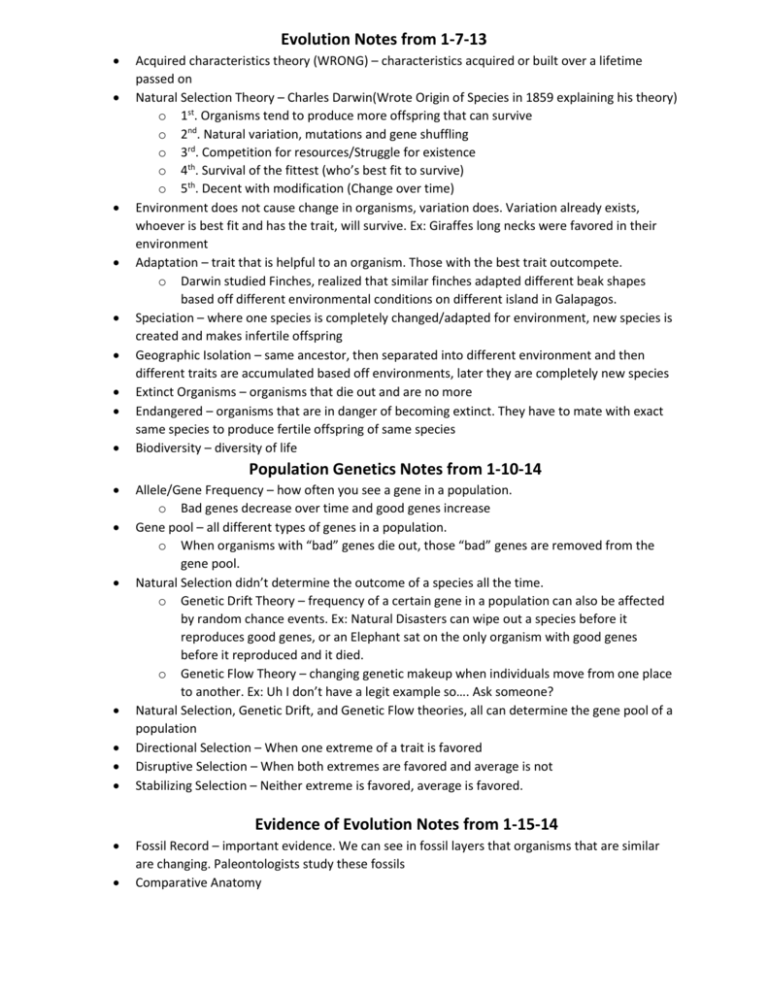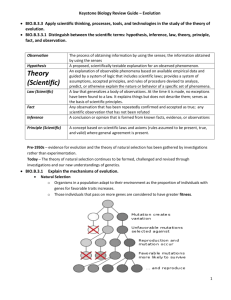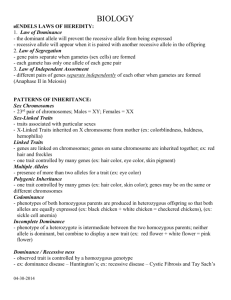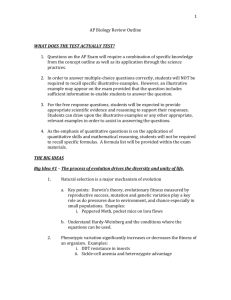Evolution Test Review
advertisement

Evolution Notes from 1-7-13 Acquired characteristics theory (WRONG) – characteristics acquired or built over a lifetime passed on Natural Selection Theory – Charles Darwin(Wrote Origin of Species in 1859 explaining his theory) o 1st. Organisms tend to produce more offspring that can survive o 2nd. Natural variation, mutations and gene shuffling o 3rd. Competition for resources/Struggle for existence o 4th. Survival of the fittest (who’s best fit to survive) o 5th. Decent with modification (Change over time) Environment does not cause change in organisms, variation does. Variation already exists, whoever is best fit and has the trait, will survive. Ex: Giraffes long necks were favored in their environment Adaptation – trait that is helpful to an organism. Those with the best trait outcompete. o Darwin studied Finches, realized that similar finches adapted different beak shapes based off different environmental conditions on different island in Galapagos. Speciation – where one species is completely changed/adapted for environment, new species is created and makes infertile offspring Geographic Isolation – same ancestor, then separated into different environment and then different traits are accumulated based off environments, later they are completely new species Extinct Organisms – organisms that die out and are no more Endangered – organisms that are in danger of becoming extinct. They have to mate with exact same species to produce fertile offspring of same species Biodiversity – diversity of life Population Genetics Notes from 1-10-14 Allele/Gene Frequency – how often you see a gene in a population. o Bad genes decrease over time and good genes increase Gene pool – all different types of genes in a population. o When organisms with “bad” genes die out, those “bad” genes are removed from the gene pool. Natural Selection didn’t determine the outcome of a species all the time. o Genetic Drift Theory – frequency of a certain gene in a population can also be affected by random chance events. Ex: Natural Disasters can wipe out a species before it reproduces good genes, or an Elephant sat on the only organism with good genes before it reproduced and it died. o Genetic Flow Theory – changing genetic makeup when individuals move from one place to another. Ex: Uh I don’t have a legit example so…. Ask someone? Natural Selection, Genetic Drift, and Genetic Flow theories, all can determine the gene pool of a population Directional Selection – When one extreme of a trait is favored Disruptive Selection – When both extremes are favored and average is not Stabilizing Selection – Neither extreme is favored, average is favored. Evidence of Evolution Notes from 1-15-14 Fossil Record – important evidence. We can see in fossil layers that organisms that are similar are changing. Paleontologists study these fossils Comparative Anatomy o Homologous Structures – we all have similar anatomical parts/structures but they have different functions o Vestigial Structures – leftover structures from evolution that serve no purpose. Ex: Whales have hip bones that serve no purpose now. It is said that they had legs as they are mammals. Humans have tailbones, suggesting we had tails and that we were once monkeys. o Embryology – all vertebrates have a similar embryonic stage. Biochemical – testing DNA of different organisms. All life has same universal code. Finding differences in amino acid chains. o The more differences in chains of two organisms means they branched off longer back o Cladogram – diagram showing evolutionary relationships Geographical Distribution – organisms distributed around the world have similar characteristics o Before the continents drifted apart, a single species is present. When continents drifted apart, the species evolved differently into new species. o Convergent Evolution – different species becoming similar based off environmental pressures o Divergent Evolution – similar species becoming different o Parallel Evolution – not becoming similar or different, just evolving together. When organisms specialize at gathering resources, that trait is favored. Other Important Information Horse Evolution o Hyracotherium Mesohippus Merychippus Equus o Over time, habitat changed from forest to plains. Food and resources change, defense strategies change, shelters change. o Horses moved from forest to grasslands so over time they adapted to become larger and stronger, food changed so larger flatter molars developed. Had to be able to run faster so toes disappeared too hooves and legs became longer and stronger. Adapting is not a matter of choice but chance that an organism has a beneficial genetic variation Variation – a different phenotype for a trait in a species Mutation – a genetic variation in genetic code Industrial Melanism – term used to describe the adaptation of an organism in response to industrial pollution. The few Black peppered moths in England survived after the trees changed to a darker color due to pollution. The white peppered moths died since birds could spot them on dark colored trees. Hardy Weingerburg Equilibrium – G.H Hardy and W. Weinburg stated that if 5 conditions are met, then the population’s alleles and genotype frequency won’t change (no evolution). o There are no mutations of alleles o The breeding population is large o Mating is random o There is no immigration or emigration o There is no natural selection (all genotypes are equally fit for the environment) I MIGHT NOT HAVE INCLUDED EVERYTHING -MADHAV











